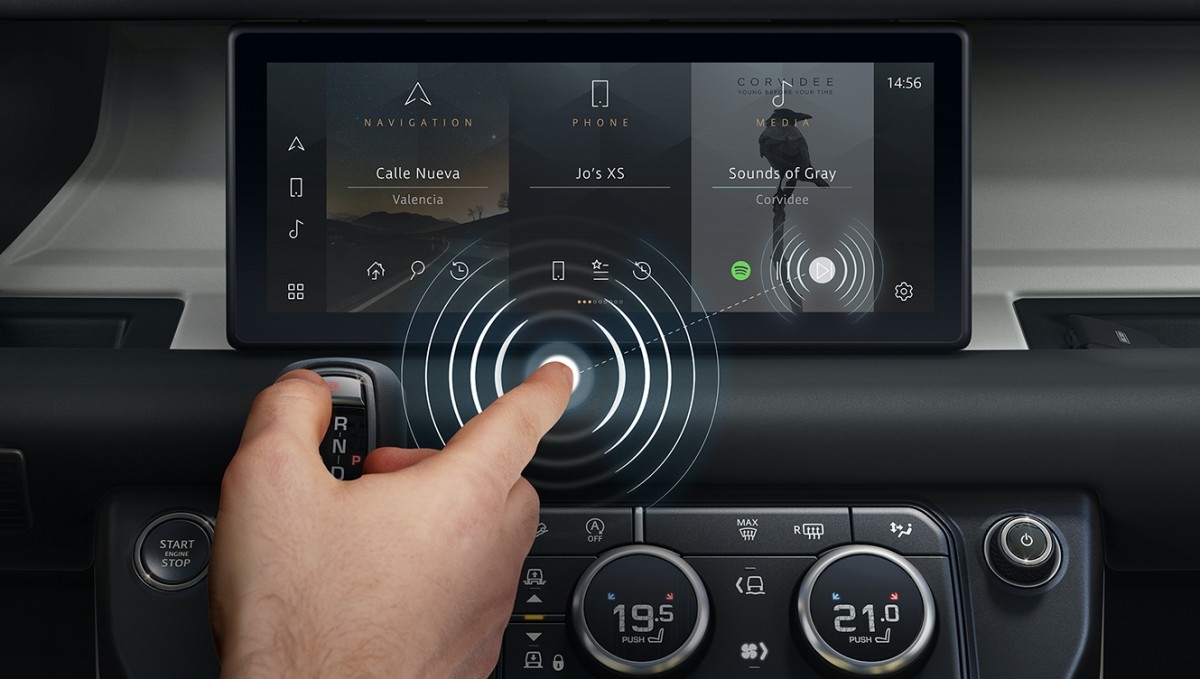Featured
Now for contactless ‘touch-screens’
Patented technology from Jaguar Land Rover offers the dual benefit of keeping drivers’ eyes on the road and reducing the spread of bacteria and viruses in a post-Covid-19 world
Share
- Click to share on Twitter (Opens in new window)
- Click to share on Facebook (Opens in new window)
- Click to share on LinkedIn (Opens in new window)
- Click to email a link to a friend (Opens in new window)
- Click to share on Reddit (Opens in new window)
- Click to share on WhatsApp (Opens in new window)
- Click to share on Pinterest (Opens in new window)
Jaguar Land Rover (JLR) and the University of Cambridge have developed new contactless touchscreen technology designed to reduce the spread of bacteria and viruses in a post-Covid-19 world.
The patented technology, called “predictive touch”, uses artificial intelligence and sensors to predict a user’s intended target on the touchscreen – whether that’s satellite navigation, temperature controls or entertainment settings – without touching a button.
Developed with engineers at the University of Cambridge, the system is part of JLR’s Destination Zero vision – a desire to make its vehicles safer and the environment cleaner and healthier.
In the “new normal” once lockdowns around the world are lifted, a greater emphasis will be placed on safe, clean mobility, where personal space and hygiene will carry premiums. JLR says its vehicles are already designed to help improve passenger well-being, with innovations including a Driver Condition Monitor, engine noise cancellation and cabin air ionisation, with PM2.5 filtration to capture ultrafine particles and allergens.
“New technology like predictive touch is another step forward as we address the wider landscape of mobility, from how customers connect with mobility services, to the infrastructure required to enable fully integrated, autonomous vehicles in our cities, like Project Vector,” says JLR.
Lab-tests and on-road trials showed the predictive touch technology could reduce a driver’s touchscreen interaction effort and time by up to 50%, as well as limiting the spread of bacteria and viruses.
Uneven or poor road surfaces can often cause vibrations that make it difficult to select the correct button on a touchscreen. This means drivers must take their attention away from the road, increasing the risk of an accident.
The technology uses artificial intelligence to determine the item the user intends to select on the screen early in the pointing task, speeding up the interaction. A gesture tracker uses vision-based or radio frequency-based sensors, which are increasingly common in consumer electronics, to combine contextual information such as user profile, interface design and environmental conditions with data available from other sensors, such as an eye-gaze tracker, to infer the user’s intent in real time.
“As countries around the world exit lockdown, we notice how many everyday consumer transactions are conducted using touchscreens: railway or cinema tickets,” says Lee Skrypchuk, a human-machine interface technical specialist at JLR. “ATMs, airport check-ins and supermarket self-service checkouts, as well as many industrial and manufacturing applications. Predictive touch technology eliminates the need to touch an interactive display and could therefore reduce the risk of spreading bacteria or viruses on surfaces.
“The technology also offers us the chance to make vehicles safer by reducing the cognitive load on drivers and increasing the amount of time they can spend focused on the road ahead. This is a key part of our Destination Zero journey.”
This software-based solution for contactless interactions has reached high technology readiness levels and can be seamlessly integrated into existing touchscreens and interactive displays, so long as the correct sensory data is available to support the machine learning algorithm.
Project leader Professor Simon Godsill, of Cambridge University’s Department of Engineering, says: “Touchscreens and other interactive displays are something most people use multiple times per day, but they can be difficult to use while in motion, whether that’s driving a car or changing the music on your phone while you’re running. We also know that certain pathogens can be transmitted via surfaces, so this technology could help reduce the risk for that type of transmission.”
Share
- Click to share on Twitter (Opens in new window)
- Click to share on Facebook (Opens in new window)
- Click to share on LinkedIn (Opens in new window)
- Click to email a link to a friend (Opens in new window)
- Click to share on Reddit (Opens in new window)
- Click to share on WhatsApp (Opens in new window)
- Click to share on Pinterest (Opens in new window)
| Thank you for Signing Up |

















